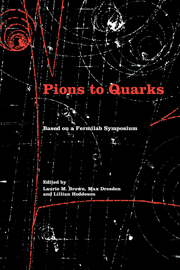Book contents
- Frontmatter
- Contents
- List of contributors
- Foreword by Leon M. Lederman
- Editors' acknowledgments
- Photographs of the symposium
- List of abbreviations
- List of notation
- I Introduction
- II Particle discoveries in cosmic rays
- III High-energy nuclear physics
- IV The new laboratory
- V The strange particles
- VI Weak interactions
- VII Weak interactions and parity nonconservation
- VIII The particle physics community
- IX Theories of hadrons
- 39 The early S-matrix theory and its propagation (1942–1952)
- 40 From field theory to phenomenology: the history of dispersion relations
- 41 Particles as S-matrix poles: hadron democracy
- 42 The general theory of quantized fields in the 1950s
- 43 The classification and structure of hadrons
- 44 Gauge principle, vector-meson dominance, and spontaneous symmetry breaking
- X Personal overviews
- Name index
- Subject index
41 - Particles as S-matrix poles: hadron democracy
Published online by Cambridge University Press: 07 May 2010
- Frontmatter
- Contents
- List of contributors
- Foreword by Leon M. Lederman
- Editors' acknowledgments
- Photographs of the symposium
- List of abbreviations
- List of notation
- I Introduction
- II Particle discoveries in cosmic rays
- III High-energy nuclear physics
- IV The new laboratory
- V The strange particles
- VI Weak interactions
- VII Weak interactions and parity nonconservation
- VIII The particle physics community
- IX Theories of hadrons
- 39 The early S-matrix theory and its propagation (1942–1952)
- 40 From field theory to phenomenology: the history of dispersion relations
- 41 Particles as S-matrix poles: hadron democracy
- 42 The general theory of quantized fields in the 1950s
- 43 The classification and structure of hadrons
- 44 Gauge principle, vector-meson dominance, and spontaneous symmetry breaking
- X Personal overviews
- Name index
- Subject index
Summary
The idea of hadron democracy – that all hadrons are “composites” and nonfundamental – is not the same as the idea that all physically observable particles correspond to singularities of an analytic scattering matrix. Nevertheless, the histories of those two ideas, both of which belong to the decade under study at this symposium, are intertwined. I give here a personal recollection of the connection. I am indebted to James Cushing for allowing me a look at a preliminary version of his case study of the S-matrix program. I am forbidden from quoting Cushing and take full responsibility for what I shall say here, but his efforts have been helpful in compensating my poor memory.
Let me begin by recalling that when Marvin L. Goldberger and I worked closely together from 1946 to 1948 as students of Enrico Fermi at the University of Chicago, we learned, as did other students of that epoch, that there were a few elementary particles out of which everything was built. Among them were neutrons and protons – the building blocks of nuclei. No one then doubted the elementarity of nucleons; Fermi never expressed such a doubt to me. By the end of the fifties, there was a growing belief that no hadron deserved to be called elementary. The distinction between protons and deuterons had become blurred. I propose here to recall how the evolving understanding of the S matrix contributed to that blurring.
- Type
- Chapter
- Information
- Pions to QuarksParticle Physics in the 1950s, pp. 600 - 607Publisher: Cambridge University PressPrint publication year: 1989
- 5
- Cited by



